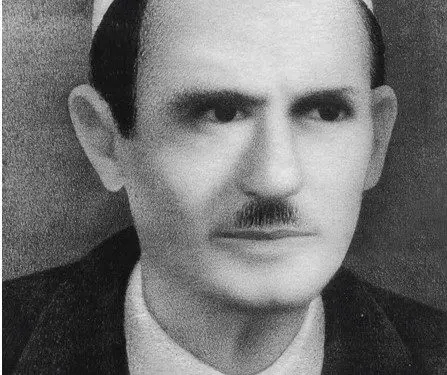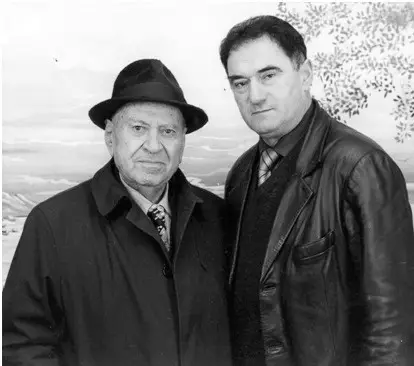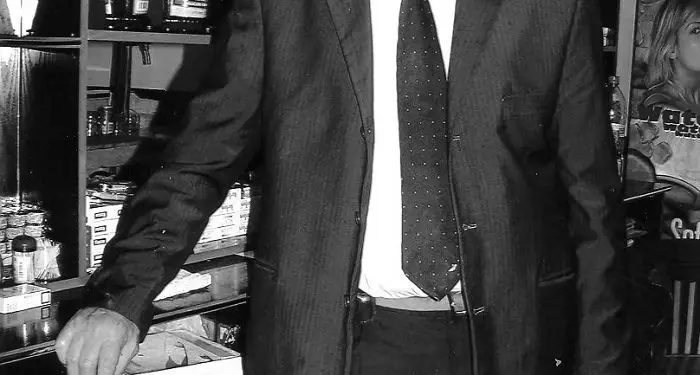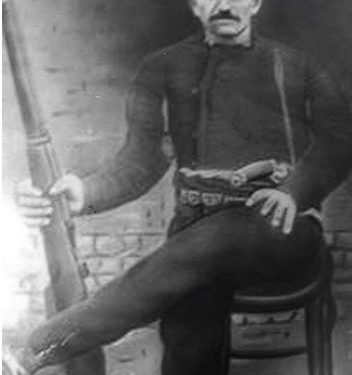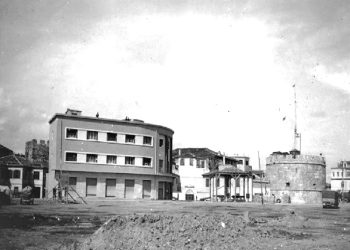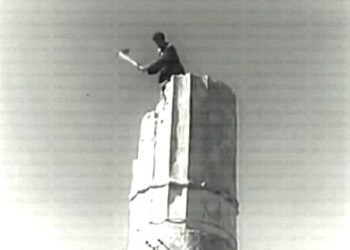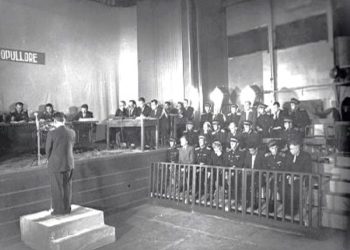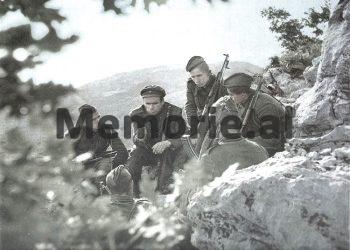From Ndue Dedaj
-“We have been our home for five hundred years, since the time of Skanderbeg, the elders told us”. –
The first part
Memorie.al / Often in the life of the people you come across facts that make you think deeply, as in the case where a mountain door, a well-known house, like that of the Qafajs of Fushë-Arres, originally from Spaçi of Mirdita, had the flag its own, just like the Albanian dynasties of the Middle Ages, the Kastriots and Dukagjins, who had coats of arms, emblems, seals, as it was believed that they also had their own guardian “hyll”. In those times, it had its own flag and province, and the flag, but also the big house, the first house, which was like a separate state. The truth is that if somewhere in the plains and cities some authentic values fell, due to the frenzy of foreign invasions, in the mountains they were preserved as survival, as life or ceremonial practices, as rituals. It is possible that the flag of the Pirusts had the appearance of an Illyrian helmet, or a copper or bronze emblem. The flag of the Principality of Arbër and that of the Dukagjins later had the same heraldry, the single-crested eagle. Mirdita’s flag was the national one, the double-headed eagle, but with the element marking the sun with rays, where the five-pointed star was later placed. The flag of Kuzhnen’s Land (bajrak) consisted of an open white hand on a red field, with a red cross on a white field, as described by Franc Nopça. It is known that in Mirdita the bride’s veil was with an eagle. The Albanian aristocracy of the mountains, which had as its basic feature the chief, could remain intact in its autochthonous essence, without being bent and alienated by the cultures of the conquests, with all its hospitable, assembly signs.
The original flag of the Qafaj: a green oak branch, on a white field
The flag of the House of the Neck was like Mirdita’s in terms of the white field, but with a green oak branch emblazoned on it, something truly original, which today would seem appropriate for some ecological party we lack. The oak was a symbol of strength, height, natural and human beauty, the soft oak branch with leaves was an expression of peace, understanding, allowing the other to pass through your territory.
That flag was put on the front of the caravans that passed from Prizren and Gjakova to Shkodër, which meant that they were in its vassalage and no one could touch them from Qafa e Mali, to the borders of Qafa-Qela across Puka. And when they didn’t have the Qafaj flag, it was enough to break an oak branch and put it around their neck, and then everyone knew they were in their clan, undoubtedly one of the most tribal Albanian customs. An oak branch that carried the bees neck to neck and mouth to mouth.
You were a distant traveler, unknown, unprotected, when you suddenly remembered that there was an unwritten law of this world, to take you under protection, to come out as a god, it was, therefore, simply an oak branch to you could snap it as soon as you stretched out your hand, and in that world you were as protected as the king of France or England, who had his guard around, even though the one who had taken you as a pledge did not know you and you did not even know him.
If a miracle could happen and you the pilgrim were killed in treachery, then you Asesi would not go without blood, because your blood would be taken from the house that had that oak branch as its banner. And this is not a legend, but an applicable docket. It has happened more than once, that the murdered man in his last agony uttered in front of some other shepherd or traveler, that I ate from so-and-so’s pears, and that was enough for him to be called “best friend” in his bread.
There was no better justice than this at that time full of social upheaval and moral outrage. The “oak branch” was indeed known as the Qafaj flag, but with the same symbolism it was used everywhere in the Kanun area, as a sign of protection for the traveler who, when he passed by your house, was enough to have that “medallion” in the garden, and it was in your possession.
The old Albanian houses had a more special status, such as those of Gjomarku, Kaloshi, Gjo Luli, Skanda, Qafa, Pervizi, Frisk, Cera, etc., since the time of the Great Weather. “Our house and Qarri i Hasi’s house were known for their generosity, they gave bread to everyone. At that time, 5-6 tables were laid for travelers a day.
At lunch, bread was eaten as much as there was, while at dinner, bread with meat was eaten for friends, travelers and pilgrims”, remember the descendants of these spies. This has been a wonderful custom in our mountains; they say this so that generosity goes out into the open, in a big way, which can be unique in the world.
You had set out to go to your work and in the meantime you found lunch laid out where the noon would find you and dinner where the night would occupy you, except that you did not know the house you were going to. There are several such bread-giving houses along the way in Mirdita, such as Qafa in Fushë-Arrë, Tuci in Simon, etc.
It is also a well-known custom to pour brandy with appetizers to the krushkus on Udha e Madhe, when they passed by your house, since they might have traveled a long way. This generosity has kept the jars “unfrozen” and seemingly indestructible.
Art on the Public Road that passes through Dukagjin
These high places in the past were rarely visited by the Bishop of Sapa (Nunshat), or the apostolic visitors of the Vatican. Frang Bardhi, our dear writer, visits churches, parishes and residents for two weeks in the summer of the distant year 1637, writing the corresponding report for the Holy See. They are a bunch of stories from that time that, thanks to Injac Zamputi, we have had them in Albanian for half a century. Frangu describes his pastoral journey in detail:
“From Kabashi we went to Ares, a village 8 miles away from Kabashi. This village of Ares has 7 houses and 51 souls…! They have the church in the name of Saint Sebastian and there they bury their dead. This church has no decorations. From Arës, on the same day, we went to Berdhet, over 8 miles away from Ares. Berdheti is a village of 19 houses and 146 souls. There is a hat on the Mother of God…!
It is placed on the Public Road that passes through Dukagji and goes to Serbia…! The Gjindja of Berdheti have often risen up against the Turks and ambushed them on the road that passes through Malzi (Shëmria e Kukës. n.d.), which is near the peoples of Spas, and they have defeated them, taken their spoils, horses and the weapons and then they still have peace, they gave the Turks a certain amount of tribute. Berdhetas are the best weapons of all Puka…”!
Although the place is called Arës Field, it is all mountainous and only where the city is built is lowland with a few flat and sloping fields, but where you can’t catch the eye and so many walnut trees. You can’t tell at first, if the name Arësit comes from arre, arre/arez or from ar (i), when the underground of these mountains is full of madam? We take a look at the old writings and we come across a note by the researcher Kol Luka: “In Fushë-Arrës, – he writes, – are the toponyms: Kroni i Fushaxhive, Vija e Fushaxhive, etc., i.e., to those who had gone down to the plateau. Even he cannot avoid Frang Bardhi, who calls the inhabitants of Arsti “ar (r) èsi (n) j” (Arëssini).
A long time passed until the other Arresin came down to join the field ones and form the new name Fushë-Arrësi. The two forms arst and arr(ë)s originate from a single form where the form arst is older. There is also the other village Arst (Arst Miliska) in Iballe. So it’s a win-win. The walnut style (aressi) at Bardhi leaves us no doubt.”
Fushë-Arrësi had strategic importance, because it was an urban center just as far from Shkodra and Prizren, 12 hours from the city at the foot of Taraboshit and Buna and 12 hours from the city next to the mountains of Sharri.
It was a perfect symmetry, as in the legends, where horse caravans had to travel a full twenty-four hours, one day and one night, to reach the next city. And if you see it from here, you can’t help but be amazed by the National Road, when it takes less than two hours to get from Shkodra to Prizren.
How far is the ballad wedding 9 hours away from Doruntina…! The well-known Shkodër-Prizren road, which passed through Gomsiqe, Pukë, Fushë-Arrëz, Qafë-Mali, Shëmri, Kukës, Morin, Prizren, with the shadow of Pashtrik, honoring the ridges, has been one of the most important roads in the North since the past times.
It connected the Adriatic to Kosovo and further to the Balkan regions and brought them down to the sea. Only thanks to this road could Shkodra, Ulqini, Shengjini, Lezha communicate with the cities of Kosovo and beyond. It was in those conditions with the features of a national road, which carried our lands from west to east, as a development factor, mainly through trade.
The Neck of the Mountain is a symbol of invincibility, for stopping the thrust of the invading Ottoman, Serbian, etc. armies, before and after the declaration of Independence (1912), transforming into a natural fortress, where the name of Ndrecë Ndue Qafë is carved through mountain stones and centuries-old pines. Already at the threshold of the League of Prizren, in the reports of the Austro-Hungarian consuls in Shkodër to Vienna, it was written that: “The mountain pass was taken by 400 Mirditas”, to stop the order of Dervish Pasha towards Mirdita, Puka, Lezha, etc.
The bravery and insurgent leadership of Qafaj, Curraj, etc. stand out there. Later, that historic Pass was crossed by the national car road, where in order not to block it from the snow, which piled up to three or four meters every winter, the whole government and the army were mobilized, because the supply and circulation with Kukës, Tropoja, Has was interrupted. etc.
Qafë-Mali, a natural tourist fortress, has often been the neck of the Theqafs. Neck with frozen krushk, as in the Epic of Kreshnik! Anyway, a neck with a history of its own, as well as Brodolec Neck, Llogara Neck, Shtama Neck, Thana Neck, etc.
Qafajt, the most famous merchant family in Pukë and Mirdita, who traded all the way to Nis in Yugoslavia
In Mirdita and Pukë, various trades have been practiced, mainly wood, stone, earth work, linen production, a small trade of family products, but large trade has not been widespread. The Neck House is among the most popular in this area, not only in this province, but far beyond. This is a special quote of hers, which deserves to be known more deeply. It was a new work culture, in the beginnings of capitalist relations in the country, if this cannot be taken for a big word.
Trade with some of the most important Albanian centers (Shkodër, Lezhë, Elbasan, Korçë, Kukës, Gjakovë, Prizren, Pejë, etc.) give a new identity to this well-known house, having a human dimension. She had the merit of introducing the concept of the market, of buying and selling, in a territory where it had not existed before.
Zef Ndue Qafa, one of the famous men of this house, told until recently about this commercial tradition of his house, about the three hospitable inns (inns) of the Qafas. In a photograph displayed in one of the salons of the descendants’ hotels in Fushë-Arres, he poses in the style of the Marubs, which must have been made by them in Shkodër, wearing a national costume, sitting on a chair, with a mustache that looks in his belt and his hand on the rifle leaning against the wall.
It is a typical look of the early mountaineer that says a lot, through his proud appearance, with a full mustache and the characteristic white “pipiruce” hat, with a Spaçi tip, which Aleksandër Stipçeviqi called of Illyrian origin.
It is interesting to examine the often complex relationship that some well-known houses have had with the high government of the country or the provincial one, including that of Qafa. Although it may not have ever been said, the conflict occurred because of a rivalry that many houses in zâ had begun to have with the Captain of Mirdita. Of course, those that were “state” houses and knew their own values and abilities.
“We were a rich house, with strong men”, writes Dede Qafa in his memoirs, implying that as such we could not be ignored by the Captain or King Zog, who, whatever it was, had an autocratic power, sometimes sometimes seeking to establish authority and where it was not possible, as the state was consolidating, while the captain’s power was declining.
The relations with the people and families of the Muslim faith in areas where the faiths met, after the Islamization of some Albanian territories, were also friendly and prominent. The house of Qafaj was friendly with the house of Bajram Aga in Kryezi.
Ndrecë Ndue Qafa, had “drank the blood” with Gjyla, the wife of Bajram Aga, to protect her as a widow, to raise orphans and not have anyone fall on her neck. This happened after the murder of her husband, Bajram, whom Ndreca had had as a lover and godfather.
This was a high noble gesture and was mentioned as such in those times by the people of Kryeziu, Qafë-Mali, Fushë-Arres, etc. Bajram Aga was a patriot, as was Mustafa Aga, the first house in the seven Bajraks, with whom we had a connection and cooperation, as the popular song says.
The different beliefs they had between them did not hinder them at all, they even went to celebrate with each other, they came to the Catholics for Easter, they went to them for Bajram, etc., a tradition that we find so prominent especially in Lura where the two faiths they lived in a house. Memorie.al
Next issue follows




